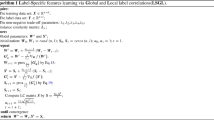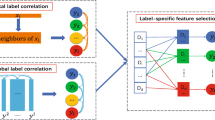Abstract
In multi-label learning, considering the relative importance between labels can yield better performance than considering the equal importance. To explore relative labeling importance, many existing algorithms introduce the global label correlations. However, the global correlations can only reflect the semantic relation between labels, while ignoring the label correlation differences between different instances. In practical applications, labels with high semantic relevance may not be highly relevant in all instances. In this paper, we consider both global and local label correlations to estimate relative labeling importance. Firstly, we calculate a global label correlation matrix in the whole label space. Secondly, each instance subset is assigned a local label correlation matrix, which is learned from the cosine similarity of labels within the cluster. Based on the assumption that label correlations can be transferred from the original categorical space to the numerical label space, we add global and local label correlation regularization terms. Finally, we integrate the importance estimating and the model training into a unified framework, and propose an alternative optimization algorithm to solve it. To validate the effectiveness of the proposed algorithm, we conduct experiments on thirteen multi-label datasets. Experimental results show that the proposed algorithm outperforms existing multi-label learning algorithms.







Similar content being viewed by others
References
Liu S M, Chen J (2015) A multi-label classification based approach for sentiment classification. Expert Syst Appl 42(3):1083–1093
Deng J, Ren F (2020) Multi-label emotion detection via emotion-specified feature extraction and emotion correlation learning. IEEE Trans Affect Comput PP(99):1–1
Castillo J R, Flores M J (2021) Web-based music genre classification for timeline song visualization and analysis. IEEE Access 9:18801–18816
Wang T, Liu L, Liu N, Zhang H, Zhang L, Feng S (2020) A multi-label text classification method via dynamic semantic representation model and deep neural network. Appl Intell 50(8):2339–2351
de Almeida A M G, Cerri R, Paraiso E C, Mantovani R G, Junior S B (2018) Applying multi-label techniques in emotion identification of short texts. Neurocomputing 320:35–46
Wu B, Lyu S, Hu B, Ji Q (2015) Multi-label learning with missing labels for image annotation and facial action unit recognition. Pattern Recognit 48(7):2279–2289
Ma Y, Xie Q, Liu Y, Xiong S (2020) A weighted knn-based automatic image annotation method. Neural Comput Appl 32(11):6559–6570
Zhang M, Zhang Q, Fang J, Li Y, Geng X (2021) Leveraging implicit relative labeling-importance information for effective multi-label learning. IEEE Trans Knowl Data Eng 33 (5):2057–2070. https://doi.org/10.1109/TKDE.2019.2951561
Hou P, Geng X, Zhang M (2016) Multi-label manifold learning. In: Proceedings of the Thirtieth AAAI conference on artificial intelligence, pp 1680–1686
Zhang Q, Zhong Y, Zhang M (2018) Feature-induced labeling information enrichment for multi-label learning. In: Proceedings of the Thirty-Second AAAI conference on artificial intelligence, pp 4446–4453
He S, Feng L, Li L (2018) Estimating latent relative labeling importances for multi-label learning. In: Proceedings of the IEEE international conference on data mining, pp 1013–1018
Luaces O, D⋅⋅̱aez J, Barranquero J, Coz JJ, Bahamonde A (2012) Binary relevance efficacy for multilabel classification. Progress in Artificial Intelligence 1(4):303–313
Fürnkranz J, Húllermeier E, Mencía EL, Brinker K (2008) Multilabel classification via calibrated label ranking. Mach Learn 73(2):133–153
Ji Z, Cui B, Li H, Jiang Y, Xiang T, Hospedales T M, Fu Y (2020) Deep ranking for image zero-shot multi-label classification. IEEE Trans Image Process 29:6549–6560
Liu H, Chen G, Li P, Zhao P, Wu X (2021) Multi-label text classification via joint learning from label embedding and label correlation. Neurocomputing 460:385–398. https://doi.org/10.1016/j.neucom.2021.07.031
Hua Y, Mou L, Zhu XX (2019) Label relation inference for multi-label aerial image classification. In: Proceedings of the 2019 IEEE international geoscience and remote sensing symposium, pp 5244–5247
Weng W, Lin Y, Wu S, Li Y, Kang Y (2018) Multi-label learning based on label-specific features and local pairwise label correlation. Neurocomputing 273:385–394. https://doi.org/10.1016/j.neucom.2017.07.044
Wang R, Ye S, Li K, Kwong S (2021) Bayesian network based label correlation analysis for multi-label classifier chain. Inf Sci 554:256–275. https://doi.org/10.1016/j.ins.2020.12.010
Nazmi S, Yan X, Homaifar A, Doucette E A (2020) Evolving multi-label classification rules by exploiting high-order label correlations. Neurocomputing 417:176–186
Huang SJ, Zhou ZH (2012) Multi-label learning by exploiting label correlations locally. In: Proceedings of the Twenty-Sixth AAAI conference on artificial intelligence, pp 949–955
Huang Z (1997) A fast clustering algorithm to cluster very large categorical data sets in data mining. In: Workshop on research issues on data mining and knowledge discovery, DMKD 1997 in cooperation with ACM SIGMOD’97, Tucson, Arizona, USA, May 11, 1997
Huang Z (1998) Extensions to the k-means algorithm for clustering large data sets with categorical values. Data Min Knowl Disc 2(3):283–304
Bandyopadhyay A, Deb K, Das A, Bag R (2020) Impulse noise removal by k-means clustering identified fuzzy filter: a new approach. Turk J Electr Eng Comput Sci 28
Schubiger M, Banjac G, Lygeros J (2020) GPU Acceleration of ADMM for large-scale quadratic programming. J Parallel Distributed Comput 144:55–67. https://doi.org/10.1016/j.jpdc.2020.05.021
Zhang M, Zhou Z (2014) A review on multi-label learning algorithms. IEEE Trans Knowl Data Eng 26(8):1819–1837
Demiar J, Schuurmans D (2006) Statistical comparisons of classifiers over multiple data sets. J Mach Learn Res 7(1):1–30
Acknowledgements
This work was supported by the National Natural Science Foundation of China (under grants 61976128, 61773247).
Author information
Authors and Affiliations
Corresponding author
Additional information
Publisher’s note
Springer Nature remains neutral with regard to jurisdictional claims in published maps and institutional affiliations.
Appendices
Appendix A:: comparison results of label correlations

Appendix B:: experimental results of convergence

Rights and permissions
About this article
Cite this article
Liu, Y., Cao, F. A relative labeling importance estimation algorithm based on global-local label correlations for multi-label learning. Appl Intell 53, 4940–4958 (2023). https://doi.org/10.1007/s10489-022-03700-3
Accepted:
Published:
Issue Date:
DOI: https://doi.org/10.1007/s10489-022-03700-3




